Hyperspectral Anomaly Detection Based on Improved RPCA with Non-Convex Regularization
Abstract
:1. Introduction
- (1)
- The rank function of a low-rank item is replaced by a weighted nuclear norm;
- (2)
- The Capped -norm is used to replace the operator of the sparse item;
- (3)
- The proposed method adopts improved RPCA models to detect anomalies, anomalies are modeled by the sparse component, and background is modeled by the low-rank component. The experimental results on four real HSI datasets show that the proposed LRSNCR method has better detection performance than other methods and can better separate the background and anomalies.
2. Methodology
| Algorithm 1 LRSNCR |
| Input:; , ; Output: L, S 1: Initializiation: , , , ; 2: repeat 3: Fix other variables as the latest value, and 4: update variable S according to Equations (6)–(10); 5: Fix other variables as the latest value, and 6: update variable L according to Equations (11)–(14); 7: Update the Y according to Equation (15); 8: Update the according to Equation (16); 9: until L and S converges or k > |
3. Experimentation Results and Discussion
3.1. Hyperspectral Datasets
3.2. Evaluation Metrics and Parameter Tuning
3.2.1. Evaluation Metrics
3.2.2. Parameter Tuning
3.3. Detection Performance and Discussion
4. Conclusions
Author Contributions
Funding
Institutional Review Board Statement
Informed Consent Statement
Data Availability Statement
Acknowledgments
Conflicts of Interest
References
- Bioucas-Dias, J.M.; Plaza, A.; Camps-Valls, G.; Scheunders, P.; Nasrabadi, N.; Chanussot, J. Hyperspectral Remote Sensing Data Analysis and Future Challenges. IEEE Geosci. Remote Sens. Mag. 2013, 1, 6–36. [Google Scholar] [CrossRef] [Green Version]
- Jiang, M.; Fang, Y.; Su, Y.; Cai, G.; Han, G. Random Subspace Ensemble With Enhanced Feature for Hyperspectral Image Classification. IEEE Geosci. Remote Sens. Lett. 2020, 17, 1373–1377. [Google Scholar] [CrossRef]
- Li, W.; Du, Q. Collaborative Representation for Hyperspectral Anomaly Detection. IEEE Trans. Geosci. Remote Sens. 2015, 53, 1463–1474. [Google Scholar] [CrossRef]
- Su, Y.; Xu, X.; Li, J.; Qi, H.; Gamba, P.; Plaza, A. Deep Autoencoders With Multitask Learning for Bilinear Hyperspectral Unmixing. IEEE Trans. Geosci. Remote Sens. 2020, 59, 8615–8629. [Google Scholar] [CrossRef]
- Zhu, X.; Cao, L.; Wang, S.; Gao, L.; Zhong, Y. Anomaly Detection in Airborne Fourier Transform Thermal Infrared Spectrometer Images Based on Emissivity and a Segmented Low-Rank Prior. Remote Sens. 2021, 13, 754. [Google Scholar] [CrossRef]
- Shimoni, M.; Haelterman, R.; Perneel, C. Hypersectral Imaging for Military and Security Applications: Combining Myriad Processing and Sensing Techniques. IEEE Geosci. Remote Sens. Mag. 2019, 7, 101–117. [Google Scholar] [CrossRef]
- Zhao, X.; Hou, Z.; Wu, X.; Li, W.; Ma, P.; Tao, R. Hyperspectral target detection based on transform domain adaptive constrained energy minimization. Int. J. Appl. Earth Obs. Geoinf. 2021, 103, 102461. [Google Scholar] [CrossRef]
- Liu, J.; Hou, Z.; Li, W.; Tao, R.; Orlando, D.; Li, H. Multipixel Anomaly Detection With Unknown Patterns for Hyperspectral Imagery. IEEE Trans. Neural Netw. Learn. Syst. 2021, 1–11. [Google Scholar] [CrossRef]
- Hou, Z.; Wei, L.; Tao, R.; Shi, W. Collaborative Representation with Background Purification and Saliency Weight for Hyperspectral Anomaly Detection. Sci. China Inf. Sci. 2022, 65, 112305. [Google Scholar] [CrossRef]
- Zhao, R.; Du, B.; Zhang, L. A Robust Nonlinear Hyperspectral Anomaly Detection Approach. IEEE J. Sel. Top. Appl. Earth Obs. Remote Sens. 2014, 7, 1227–1234. [Google Scholar] [CrossRef]
- Du, B.; Zhang, L. Random-Selection-Based Anomaly Detector for Hyperspectral Imagery. IEEE Trans. Geosci. Remote Sens. 2011, 49, 1578–1589. [Google Scholar] [CrossRef]
- Zhao, C.; Li, C.; Feng, S. A Spectral–Spatial Method Based on Fractional Fourier Transform and Collaborative Representation for Hyperspectral Anomaly Detection. IEEE Geosci. Remote Sens. Lett. 2021, 18, 1259–1263. [Google Scholar] [CrossRef]
- Reed, I.; Yu, X. Adaptive multiple-band CFAR detection of an optical pattern with unknown spectral distribution. IEEE Trans. Acoust. Speech Signal Process. 1990, 38, 1760–1770. [Google Scholar] [CrossRef]
- Zhao, C.; Li, C.; Feng, S.; Su, N.; Li, W. A Spectral–Spatial Anomaly Target Detection Method Based on Fractional Fourier Transform and Saliency Weighted Collaborative Representation for Hyperspectral Images. IEEE J. Sel. Top. Appl. Earth Obs. Remote Sens. 2020, 13, 5982–5997. [Google Scholar] [CrossRef]
- Borghys, D.; Kasen, I.; Achard, V.; Perneel, C.; Shen, S.S.; Lewis, P.E. Comparative evaluation of hyperspectral anomaly detectors in different types of background. Int. Soc. Opt. Photonics 2012, 8390, 83902J. [Google Scholar]
- Guo, Q.; Zhang, B.; Ran, Q.; Gao, L.; Li, J.; Plaza, A. Weighted-RXD and Linear Filter-Based RXD: Improving Background Statistics Estimation for Anomaly Detection in Hyperspectral Imagery. IEEE J. Sel. Top. Appl. Earth Obs. Remote Sens. 2014, 7, 2351–2366. [Google Scholar] [CrossRef]
- Kwon, H.; Nasrabadi, N. Kernel RX-algorithm: A nonlinear anomaly detector for hyperspectral imagery. IEEE Trans. Geosci. Remote Sens. 2005, 43, 388–397. [Google Scholar] [CrossRef]
- Khazai, S.; Homayouni, S.; Safari, A.; Mojaradi, B. Anomaly Detection in Hyperspectral Images Based on an Adaptive Support Vector Method. IEEE Geosci. Remote Sens. Lett. 2011, 8, 646–650. [Google Scholar] [CrossRef]
- Matteoli, S.; Diani, M.; Corsini, G. Hyperspectral Anomaly Detection With Kurtosis-Driven Local Covariance Matrix Corruption Mitigation. IEEE Geosci. Remote Sens. Lett. 2011, 8, 532–536. [Google Scholar] [CrossRef]
- Du, L.; Wu, Z.; Xu, Y.; Liu, W.; Wei, Z. Kernel low-rank representation for hyperspectral image classification. In Proceedings of the 2016 IEEE International Geoscience and Remote Sensing Symposium (IGARSS), Beijing, China, 10–15 July 2016; pp. 477–480. [Google Scholar] [CrossRef]
- Li, L.; Li, W.; Du, Q.; Tao, R. Low-Rank and Sparse Decomposition With Mixture of Gaussian for Hyperspectral Anomaly Detection. IEEE Trans. Cybern. 2021, 51, 4363–4372. [Google Scholar] [CrossRef]
- Zhou, T.; Tao, D. GoDec: Randomized Lowrank & Sparse Matrix Decomposition in Noisy Case. In Proceedings of the International Conference on Machine Learning, Bellevue, WA, USA, 28 June–2 July 2011. [Google Scholar]
- Zhang, Y.; Du, B.; Zhang, L.; Wang, S. A Low-Rank and Sparse Matrix Decomposition-Based Mahalanobis Distance Method for Hyperspectral Anomaly Detection. IEEE Trans. Geosci. Remote Sens. 2016, 54, 1376–1389. [Google Scholar] [CrossRef]
- Xu, Y.; Wu, Z.; Li, J.; Plaza, A.; Wei, Z. Anomaly Detection in Hyperspectral Images Based on Low-Rank and Sparse Representation. IEEE Trans. Geosci. Remote Sens. 2016, 54, 1990–2000. [Google Scholar] [CrossRef]
- Zhang, X.; Wen, G.; Dai, W. A Tensor Decomposition-Based Anomaly Detection Algorithm for Hyperspectral Image. IEEE Trans. Geosci. Remote Sens. 2016, 54, 5801–5820. [Google Scholar] [CrossRef]
- Candès, E.J.; Li, X.; Ma, Y.; Wright, J. Robust Principal Component Analysis? J. ACM 2011, 58, 1–37. [Google Scholar] [CrossRef]
- Sun, W.; Liu, C.; Li, J.; Lai, Y.M.; Li, W. Low-rank and sparse matrix decomposition-based anomaly detection for hyperspectral imagery. J. Appl. Remote Sens. 2014, 8, 083641. [Google Scholar] [CrossRef]
- Li, F.R. Variable Selection via Nonconcave Penalized Likelihood and its Oracle Properties. Publ. Am. Stat. Assoc. 2001, 96, 1348–1360. [Google Scholar]
- Zhang, C.H. Nearly unbiased variable selection under minimax concave penalty. Ann. Stat. 2010, 38, 894–942. [Google Scholar] [CrossRef] [Green Version]
- Zhao, X.; Li, W.; Zhang, M.; Tao, R.; Ma, P. Adaptive Iterated Shrinkage Thresholding-Based Lp-Norm Sparse Representation for Hyperspectral Imagery Target Detection. Remote Sens. 2020, 12, 3991. [Google Scholar] [CrossRef]
- Candès, E.; Wakin, M.B.; Boyd, S.P. Enhancing Sparsity by Reweighted ℓ1 Minimization. J. Fourier Anal. Appl. 2008, 14, 877–905. [Google Scholar] [CrossRef]
- Trzasko, J.; Manduca, A. Highly Undersampled Magnetic Resonance Image Reconstruction via Homotopic ℓ0-Minimization. IEEE Trans. Med. Imaging 2009, 28, 106–121. [Google Scholar] [CrossRef]
- Gong, P.; Ye, J.; Zhang, C. Multi-stage multi-task feature learning. Adv. Neural Inf. Process. Syst. 2012, 25. Available online: https://proceedings.neurips.cc/paper/2012/hash/2ab56412b1163ee131e1246da0955bd1-Abstract.html (accessed on 1 January 2022).
- Abadía-Heredia, R.; López-Martín, M.; Carro, B.; Arribas, J.; Pérez, J.; Le Clainche, S. A predictive hybrid reduced order model based on proper orthogonal decomposition combined with deep learning architectures. Expert Syst. Appl. 2022, 187, 115910. [Google Scholar] [CrossRef]
- Lopez-Martin, M.; Le Clainche, S.; Carro, B. Model-free short-term fluid dynamics estimator with a deep 3D-convolutional neural network. Expert Syst. Appl. 2021, 177, 114924. [Google Scholar] [CrossRef]
- Recht, B.; Fazel, M.; Parrilo, P.A. Guaranteed Minimum-Rank Solutions of Linear Matrix Equations via Nuclear Norm Minimization. SIAM Rev. 2010, 52, 471–501. [Google Scholar] [CrossRef] [Green Version]
- Lu, C.; Zhu, C.; Xu, C.; Yan, S.; Lin, Z. Generalized Singular Value Thresholding. Comput. Sci. 2014, 29, 8123533. [Google Scholar]
- Fazel, M. Matrix Rank Minimization with Applications. Ph.D. Thesis, Stanford University, Stanford, CA, USA, 2002. [Google Scholar]
- Gu, S.; Xie, Q.; Meng, D.; Zuo, W.; Feng, X.; Zhang, L. Weighted Nuclear Norm Minimization and Its Applications to Low Level Vision. Int. J. Comput. Vis. 2017, 121, 183–208. [Google Scholar] [CrossRef]
- Gong, P.; Zhang, C.; Lu, Z.; Huang, J.Z.; Ye, J. A General Iterative Shrinkage and Thresholding Algorithm for Non-Convex Regularized Optimization Problems. In Proceedings of the 30th International Conference on International Conference on Machine Learning, Atlanta, GA, USA, 17–19 June 2013; Volume 28, pp. 37–45. [Google Scholar]
- Lu, C.; Tang, J.; Yan, S.; Lin, Z. Nonconvex Nonsmooth Low Rank Minimization via Iteratively Reweighted Nuclear Norm. IEEE Trans. Image Process. 2016, 25, 829–839. [Google Scholar] [CrossRef] [Green Version]
- Boyd, S.; Parikh, N.; Chu, E.; Peleato, B.; Eckstein, J. Distributed Optimization and Statistical Learning via the Alternating Direction Method of Multipliers. Found. Trends Mach. Learn. 2011, 3, 1–122. [Google Scholar] [CrossRef]
- Eckstein, J.; Yao, W. Understanding the convergence of the alternating direction method of multipliers: Theoretical and computational perspectives. Pac. J. Optim. 2015, 11, 619–644. [Google Scholar]
- Huang, X.; Du, B.; Tao, D.; Zhang, L. Spatial-Spectral Weighted Nuclear Norm Minimization for Hyperspectral Image Denoising. Neurocomputing 2020, 399, 271–284. [Google Scholar] [CrossRef]
- Kang, X.; Zhang, X.; Li, S.; Li, K.; Li, J.; Benediktsson, J.A. Hyperspectral Anomaly Detection With Attribute and Edge-Preserving Filters. IEEE Trans. Geosci. Remote Sens. 2017, 55, 5600–5611. [Google Scholar] [CrossRef]
- Li, L.; Li, W.; Qu, Y.; Zhao, C.; Tao, R.; Du, Q. Prior-Based Tensor Approximation for Anomaly Detection in Hyperspectral Imagery. IEEE Trans. Neural Netw. Learn. Syst. 2020, 33, 1037–1050. [Google Scholar] [CrossRef] [PubMed]
- Herweg, J.A.; Kerekes, J.P.; Weatherbee, O.; Messinger, D.; Aardt, J.V.; Ientilucci, E.; Ninkov, Z.; Faulring, J.; Raqueño, N.; Meola, J. SpecTIR hyperspectral airborne Rochester experiment data collection campaign. Spie Def. Secur. Sens. 2012, 8390, 839028. Available online: https://scholar.archive.org/work/ombukmvtczevtarnvfnf5yx64u/access/wayback/http://twiki.cis.rit.edu/twiki/pub/Main/ShareSpecTIR/SHARE_Report_v10.pdf (accessed on 1 January 2022).
- Zhao, R.; Du, B.; Zhang, L. Hyperspectral Anomaly Detection via a Sparsity Score Estimation Framework. IEEE Trans. Geosci. Remote Sens. 2017, 55, 3208–3222. [Google Scholar] [CrossRef]
- Hou, Z.; Li, W.; Li, L.; Tao, R.; Du, Q. Hyperspectral Change Detection Based on Multiple Morphological Profiles. IEEE Trans. Geosci. Remote Sens. 2021, 60, 5507312. [Google Scholar] [CrossRef]

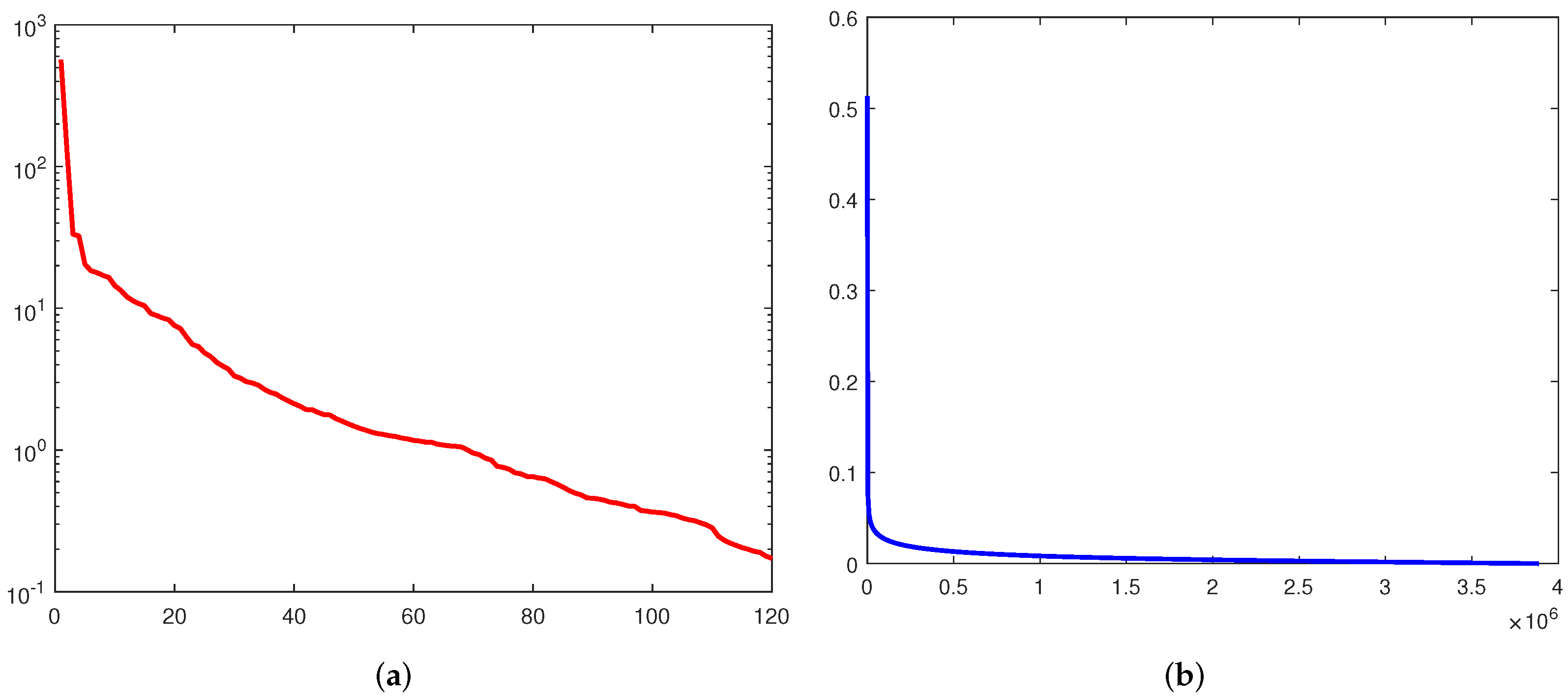


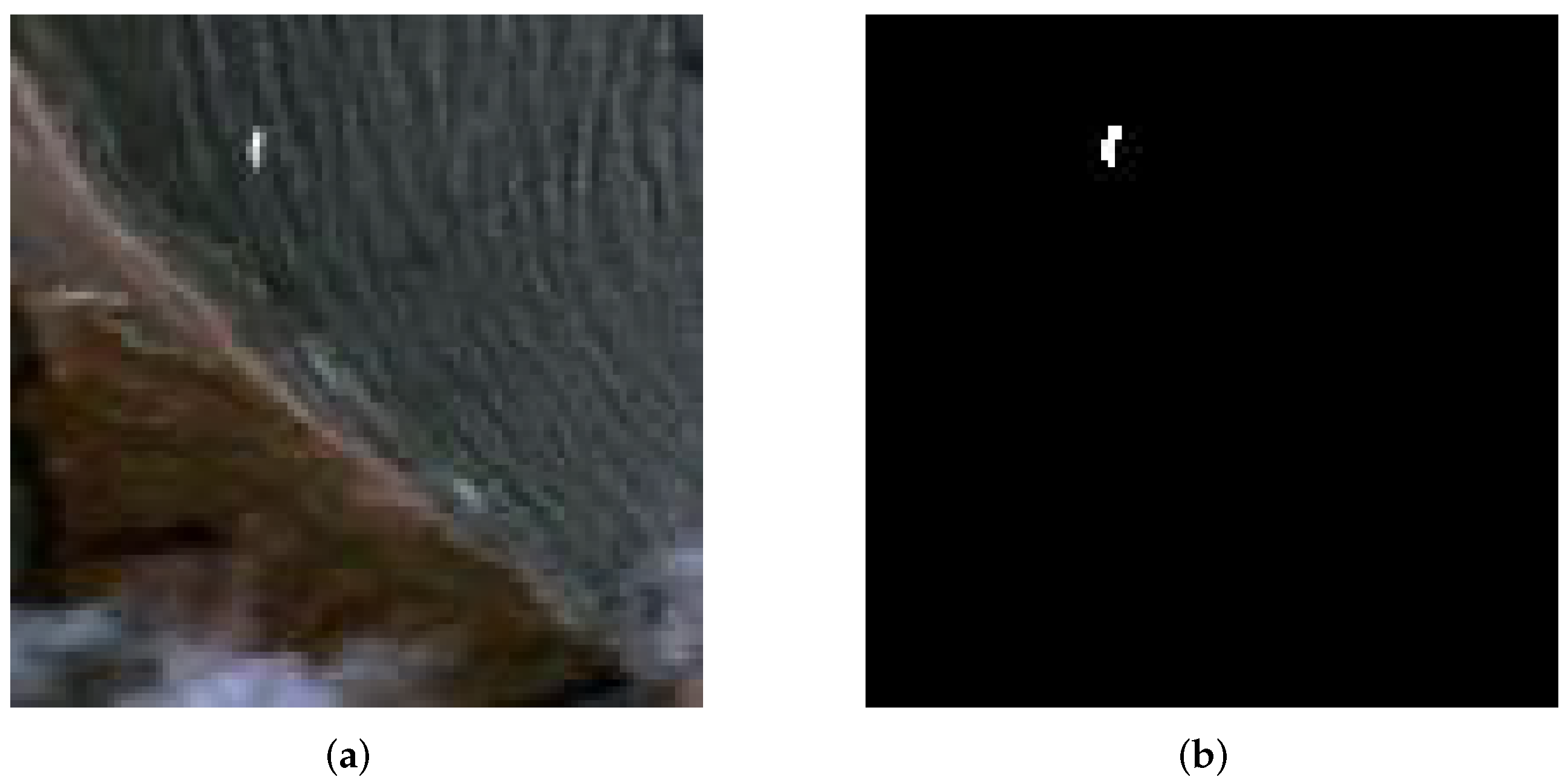

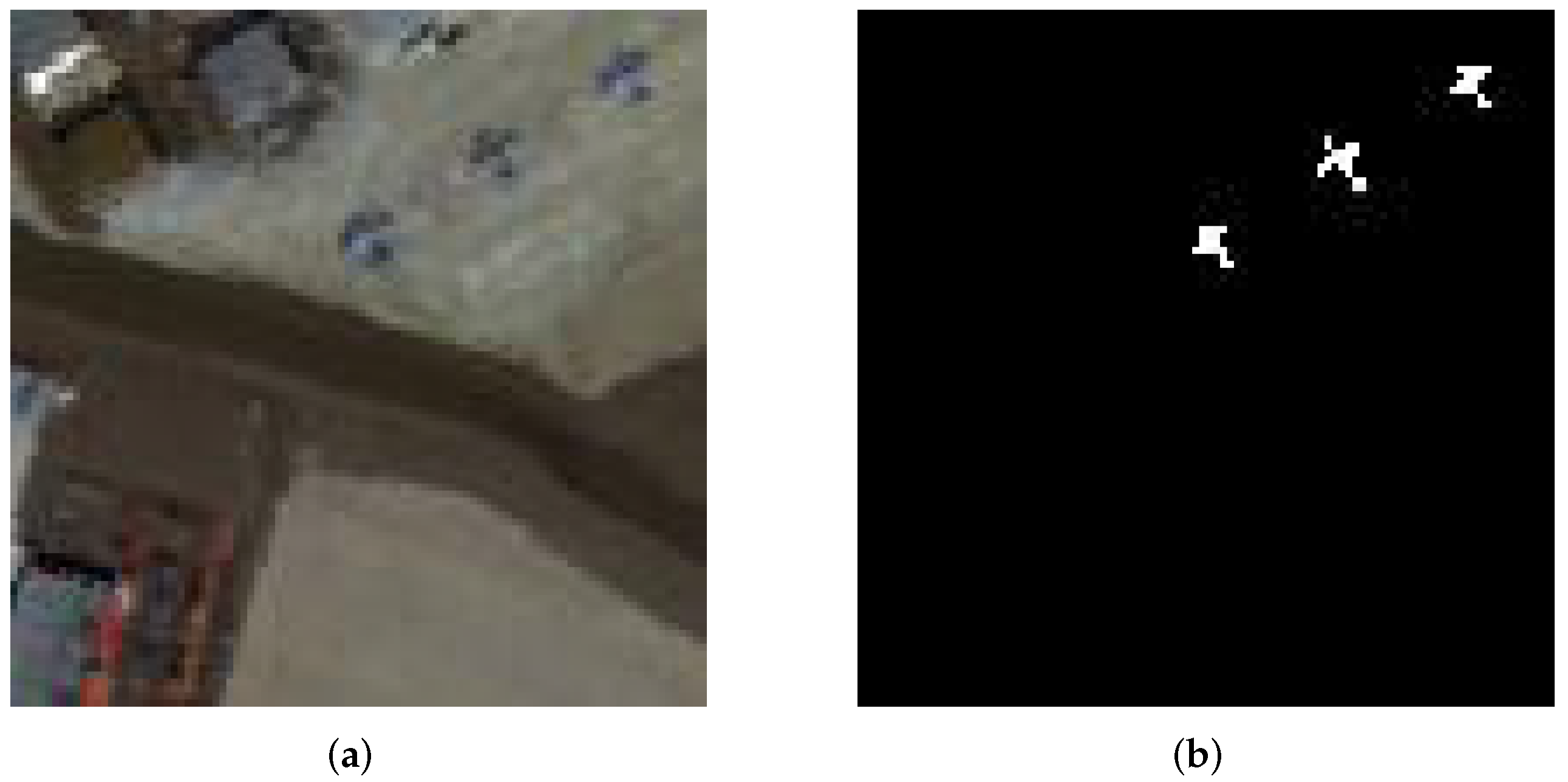
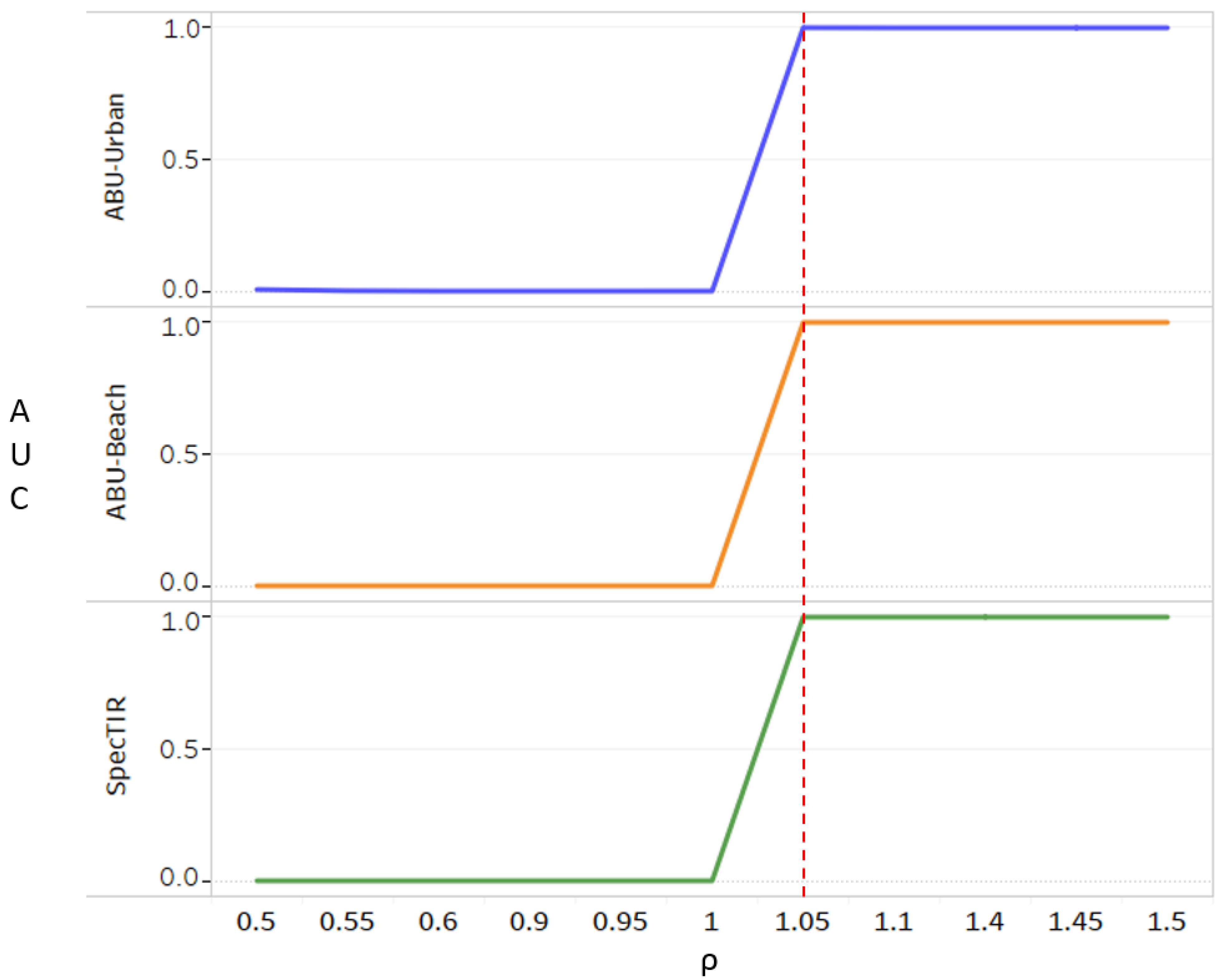
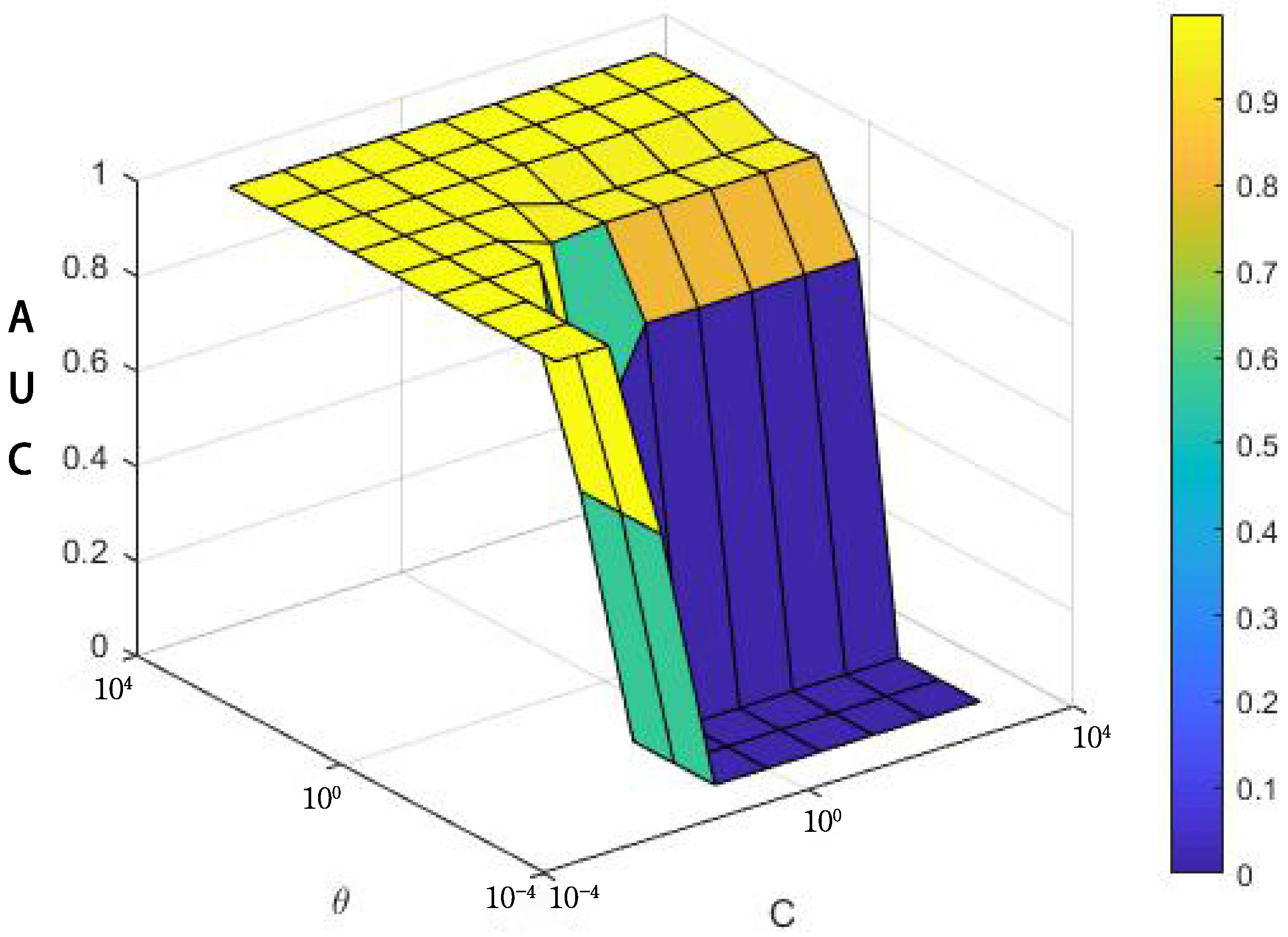
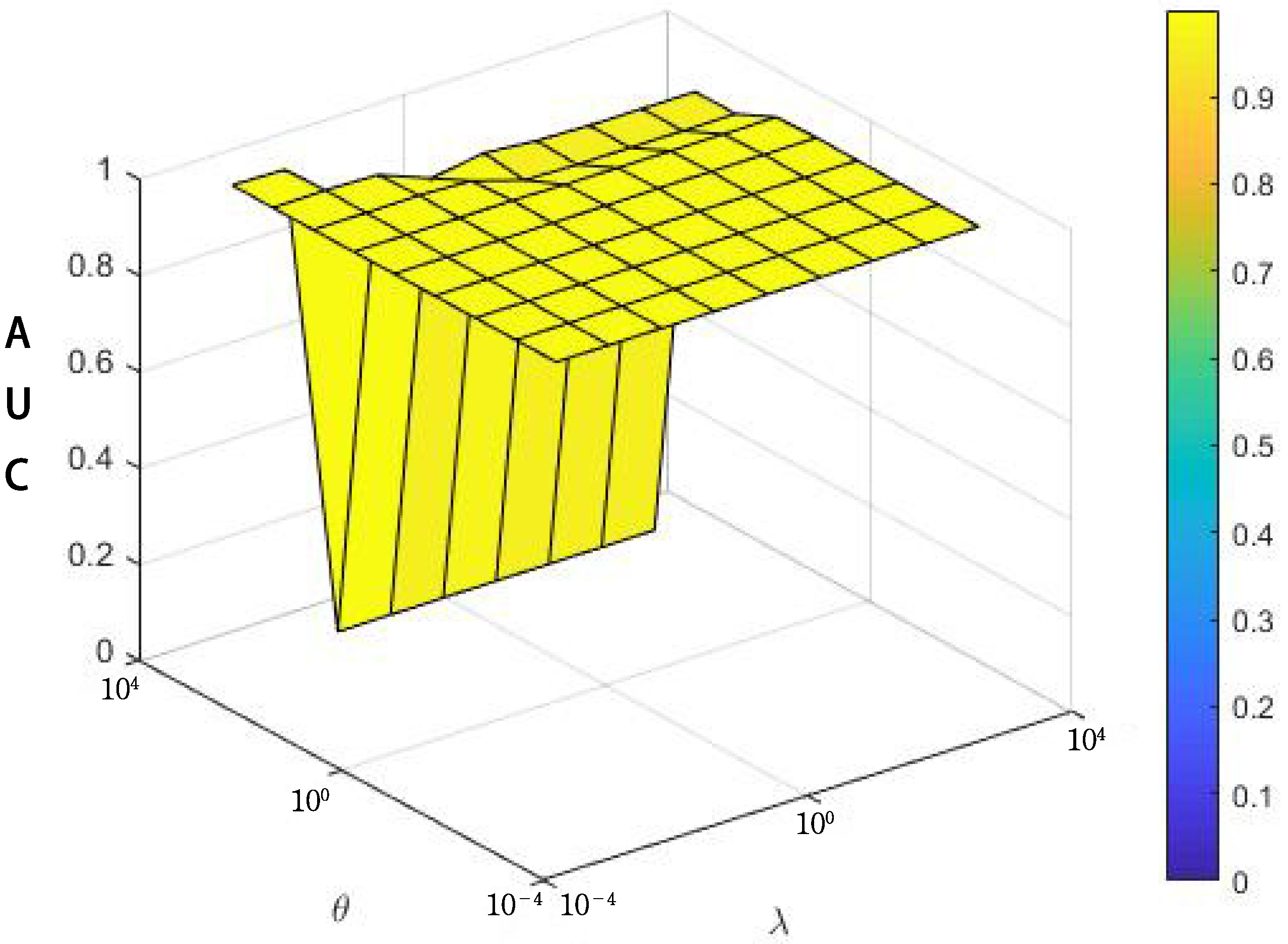
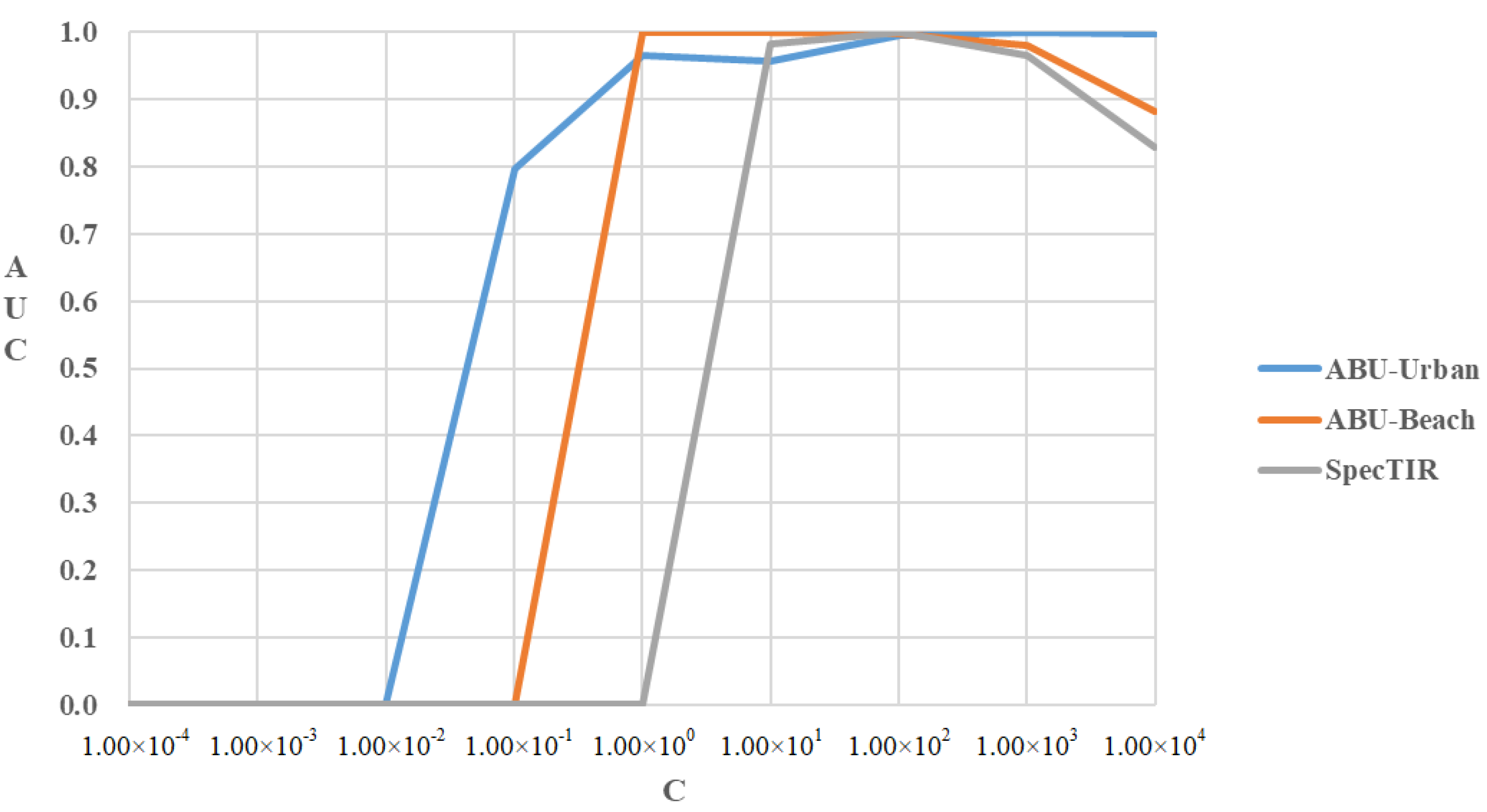




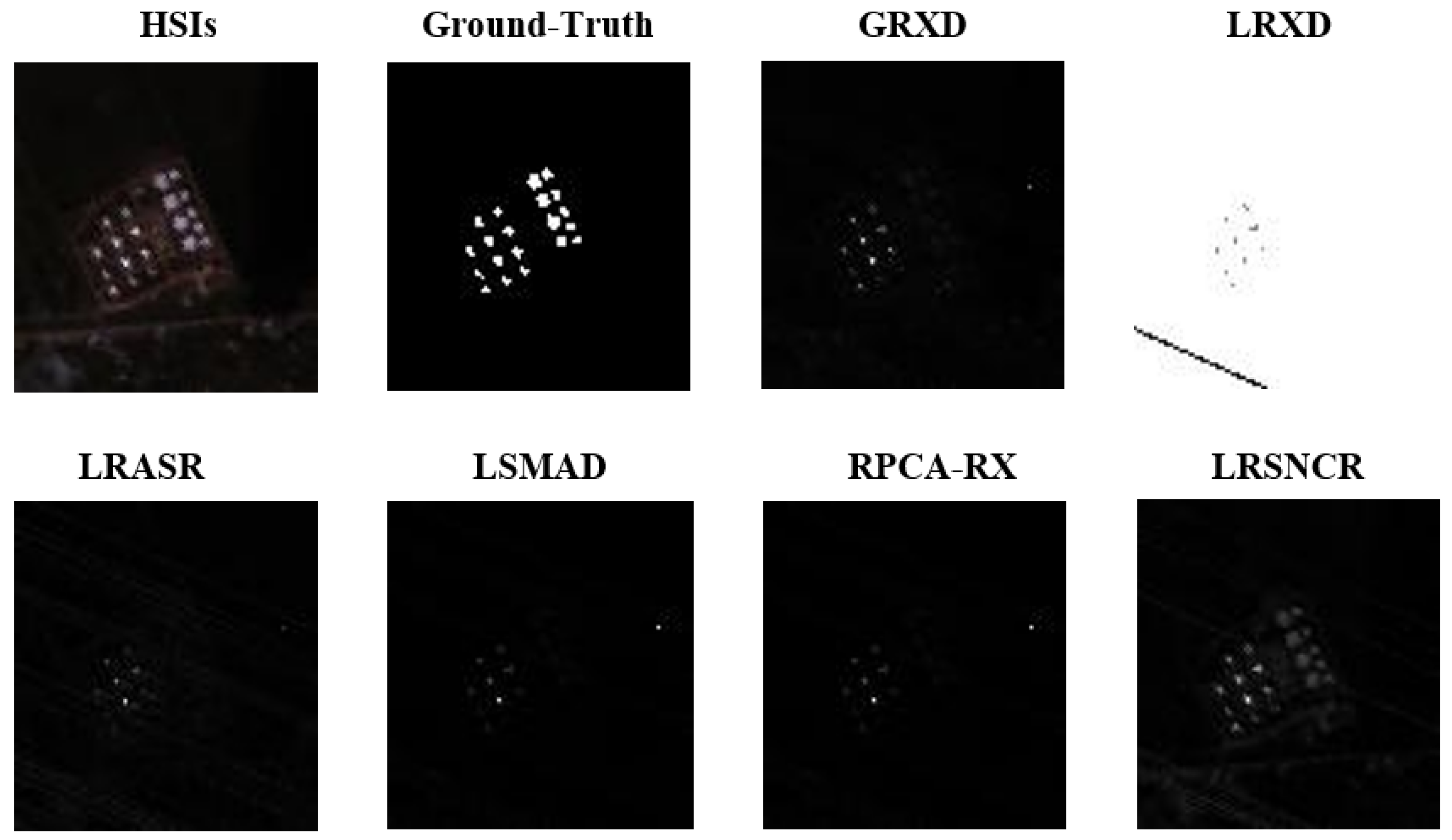





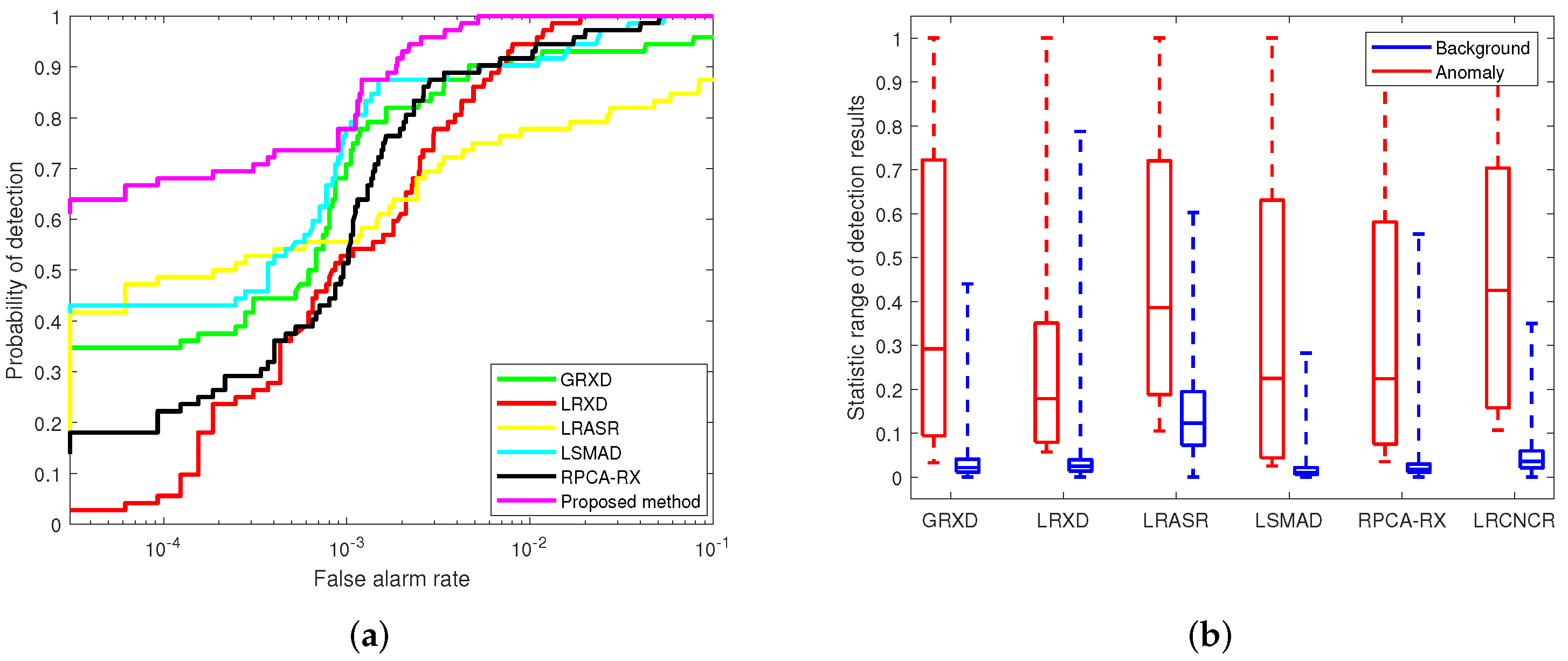
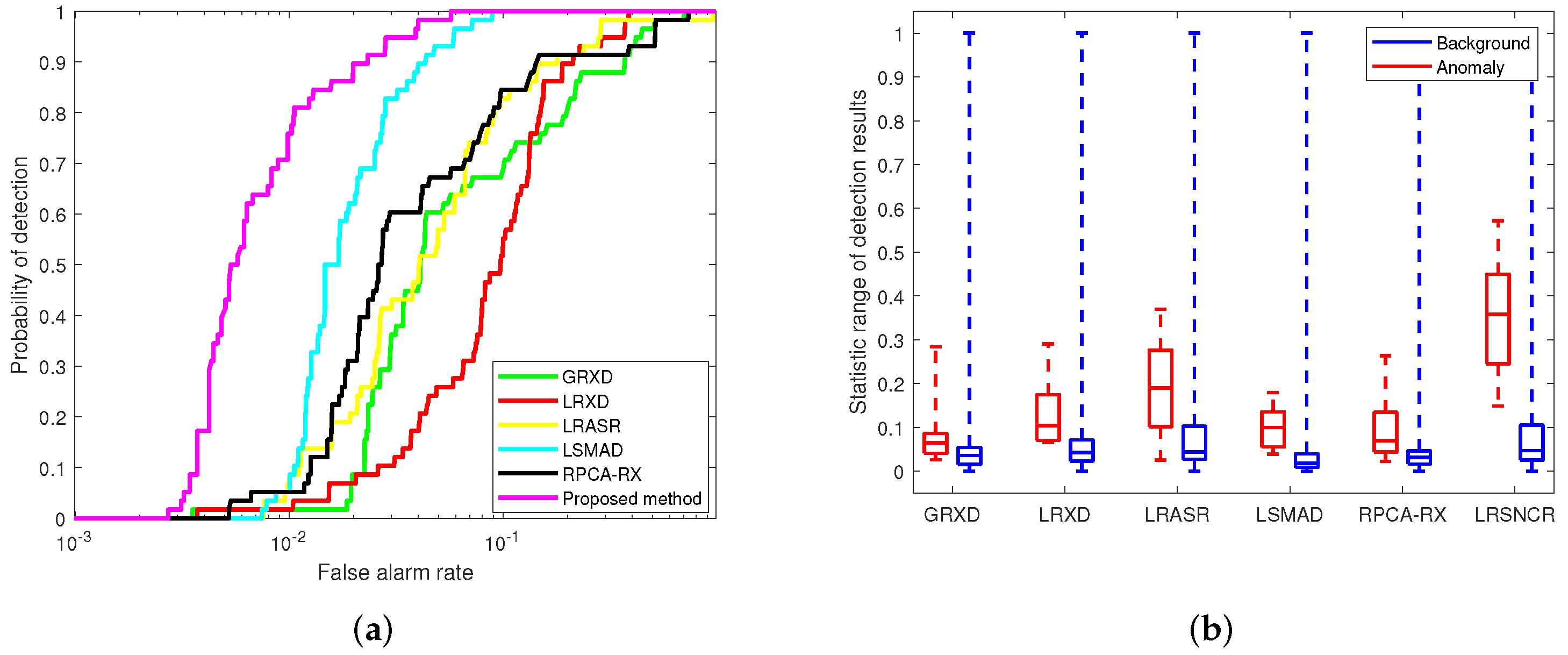
| Penalty | Formula 0 | Gradient |
|---|---|---|
| SCAD | ||
| MCP | ||
| LSP | ||
| Laplace | ||
| Capped |
| Methods | GRXD | LRXD | LRASR | LSMAD | RPCA-RX | Proposed |
|---|---|---|---|---|---|---|
| ABU-Urban | 0.9946 | 0.5713 | 0.8385 | 0.9843 | 0.9957 | 0.9991 |
| ABU-Beach | 0.9998 | 0.9736 | 0.9990 | 0.9995 | 0.9995 | 0.9999 |
| SpecTIR | 0.9914 | 0.9976 | 0.9685 | 0.9972 | 0.9971 | 0.9995 |
| Sandiego | 0.8886 | 0.8892 | 0.9200 | 0.9778 | 0.9165 | 0.9903 |
| Methods | GRXD | LRXD | LRASR | LSMAD | RPCA-RX | Proposed |
|---|---|---|---|---|---|---|
| ABU-Urban | 0.06351 | 69.55086 | 71.08300 | 24.96805 | 12.74864 | 49.83561 |
| ABU-Beach | 0.05629 | 39.46180 | 33.64385 | 9.85913 | 3.24897 | 22.08689 |
| SpecTIR | 0.10012 | 94.28799 | 89.25651 | 20.59356 | 4.78673 | 27.86498 |
| Sandiego | 0.15725 | 39.23523 | 32.22894 | 10.89012 | 3.41575 | 19.45832 |
Publisher’s Note: MDPI stays neutral with regard to jurisdictional claims in published maps and institutional affiliations. |
© 2022 by the authors. Licensee MDPI, Basel, Switzerland. This article is an open access article distributed under the terms and conditions of the Creative Commons Attribution (CC BY) license (https://creativecommons.org/licenses/by/4.0/).
Share and Cite
Yao, W.; Li, L.; Ni, H.; Li, W.; Tao, R. Hyperspectral Anomaly Detection Based on Improved RPCA with Non-Convex Regularization. Remote Sens. 2022, 14, 1343. https://doi.org/10.3390/rs14061343
Yao W, Li L, Ni H, Li W, Tao R. Hyperspectral Anomaly Detection Based on Improved RPCA with Non-Convex Regularization. Remote Sensing. 2022; 14(6):1343. https://doi.org/10.3390/rs14061343
Chicago/Turabian StyleYao, Wei, Lu Li, Hongyu Ni, Wei Li, and Ran Tao. 2022. "Hyperspectral Anomaly Detection Based on Improved RPCA with Non-Convex Regularization" Remote Sensing 14, no. 6: 1343. https://doi.org/10.3390/rs14061343
APA StyleYao, W., Li, L., Ni, H., Li, W., & Tao, R. (2022). Hyperspectral Anomaly Detection Based on Improved RPCA with Non-Convex Regularization. Remote Sensing, 14(6), 1343. https://doi.org/10.3390/rs14061343








